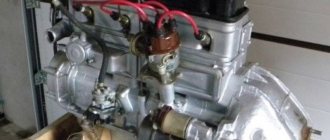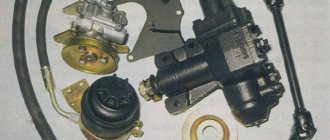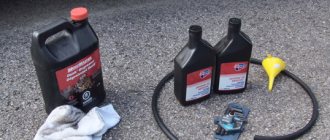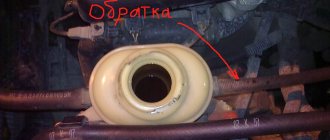Why and when you need to change the oil in the hydraulic booster, signs of fluid wear, which results from untimely replacement of the lubricant. Video about changing power steering oil.
Today, almost every car has a power steering column. Automakers use two power steering technologies - hydraulic power steering (power steering) and electric power steering (EPS). Since the second type appeared relatively recently, most models use a hydraulic system.
Why and when is it necessary to replace the power steering fluid?
It should be noted that the planned renewal of the working fluid in the hydraulic booster is carried out every 80-100 thousand kilometers. In some cases, replacement is necessary earlier, especially when connecting different components during topping up, when the properties of the previous fluid are lost (the oil has turned black) and other circumstances. Also, the hydraulic fluid is changed when the power steering unit fails or is replaced. There are several signs indicating the need for urgent replenishment of the substance.
When understanding the purposes for which the oil in the hydraulic booster is changed, it is enough to familiarize yourself with the operating principle of this mechanism. The operation of the power steering is based on the fact that with the help of a special fluid (oil) the corresponding force is transmitted to the steering elements.
But some motorists mistakenly think that the load is minimal, and the consistency itself can be used throughout the entire life of the vehicle. In practice this is a big misconception.
Fluid replacement is carried out in order to extend the service life of the unit and maintain its performance. The design of the hydraulic power steering contains the following components:
- power steering pump;
- distribution mechanism;
- power steering reservoir;
- hydraulic cylinder;
- power steering drive;
- pipes and hoses.
Many machines use rack and pinion control, which involves the joint operation of the rack and the pump. In turn, the power steering pump is driven by the vehicle's power plant using an attachment belt or electric motor, and then pumps fluid into the rack. It is important to consider that the substance moves in the system under maximum pressure.
If the wheels are in a straight position, the power steering fluid is pumped “idle”. When the steering wheel is turned in any direction, a special mechanism is activated that bypasses fluid under the influence of pressure to push the shaft installed inside the rack.
Steering rods are attached to the shaft structure to turn the wheels of the vehicle. The presence of an amplifier eliminates the need to exert great effort to rotate the steering wheel.
It is important to remember about the natural wear and tear of units and components, since the fluid in the hydraulic booster becomes clogged with chips and traces of technical wear. In addition, the composition may be subject to strong heating during operation of the mechanism.
Like other oils (transmission and motor), power steering oil contains a complex of additives that lose their properties and become ineffective. They no longer effectively protect system components from corrosion processes and natural wear. Therefore, it is easy to conclude that untimely replacement of power steering fluid significantly reduces the working life of the power steering unit. A high-quality and fresh portion of the substance reduces the load on the pump, reduces its wear and eliminates any noise during operation.
In addition, such care extends the life of oil seals, rubber seals and other elements of pumping equipment and the steering rack. Therefore, experts recommend updating the technical mixture every 100,000 km or every 5 years.
Before changing the oil in the hydraulic booster, it is necessary to drain the old compound and replace it with a compatible new one recommended by the manufacturer. But it is important to consider that different types of power steering fluids are used for different car models. Some cars use basic ATF for automatic transmissions - for example, Dexron.
How does power steering fluid work?
The composition circulating in the vehicle control system not only ensures the functioning of the entire system. Power steering fluids remove heat from parts, preventing them from overheating, and also protect against corrosion and reduce wear. For these purposes, a special substance has been developed that works normally in a wide temperature range: from minus 40 to plus 120 degrees.
Power steering design
A hydraulic unit (there are also electric units) includes several parts that are somehow connected to the fluid moving in the system. How do they function?
- Pump. A device with blades driven into rotation by the engine crankshaft through a belt drive.
- Working fluid. It is poured into a special tank and comes out from there into two channels: one leads to the pump, the second is the “return”.
- Discharge valve. It is necessary to maintain constant pressure in the system, since the engine speed is constantly changing.
- Distributor with power cylinder. They are the ones who are “engaged” in the redistribution of fluid flow when turning the steering wheel.
- Spring torsion bar. It stands at the entrance to the hydraulic booster shaft and runs inside the spool. When the steering wheel rotates, the torsion bar twists, the spool moves and opens the required channel into which the fluid flows. At the end of the torsion bar there is a gear that interacts with the steering rack.
What does a late power steering oil change lead to?
Many domestic motorists remember changing the power steering oil only after it fails. What could this lead to? The waste liquid contains a large number of small contaminants , such as:
- metal shavings;
- the smallest impurities.
The listed components seriously harm the hydraulic system, especially the filter elements located in the power steering reservoir. This part quickly becomes clogged, and the pump is under enormous loads. As a result, it fails, and there is a need for expensive repairs.
Power steering oil is not as hygroscopic as brake oil, but it does absorb condensation. The entry of water into the system provokes rapid and intense corrosion of the steering rack.
Also, condensation in the oil increases its viscosity in winter. The circulation of the substance is suspended, and an additional load is placed on the unit and its sealing components. As a result, the device is subject to depressurization, leaks and hum in the engine compartment. And in hot periods, the oil with condensation becomes excessively liquid (watery). As a result, it ceases to create optimal pressure on the wheel elements, the steering wheel becomes “heavy”, and jerks occur when trying to turn it.
If in winter, after starting the ignition, a hum is heard that gradually disappears, perhaps we are talking about overload on the pumping equipment. As a result, the service life of the system is greatly reduced. Therefore, it is recommended to change the oil before the start of the winter season if the replacement date is close. And if you plan to change the oil at the end of winter, then it is better to postpone the procedure to spring. In this case, you can avoid diluting the oil with condensation and deteriorating the effort during the warm season.
Operating principle of the steering gear
The VAZ 2107 is equipped with a worm-type steering gear. The principle of its operation is as follows.
The driver turns the steering wheel. The worm shaft is driven by cardan joints. It rotates, moving the double-ridge roller. Then the secondary shaft rotates, on which the bipod is fixed, driving the steering rods.
The trapezoid moves the steering knuckles, turning the wheels in the desired direction.
To reduce friction of the internal elements of the steering gear, transmission oil with a viscosity grade of SAE 75W-90, 80W-90 or 85W-90 is poured into the mechanism. The filling volume of the VAZ 2107 gearbox is 0.215 liters.
Signs of oil wear
There are simple instructions that allow you to determine the unsuitability of power steering oil for further use:
- it is necessary to open the power steering reservoir cover;
- You should check the normal color of the oil at the time of filling - for example, red, green or yellow. If there are leftovers of the original product, you need to pour it into a plastic cup and make a simple comparison;
- if the oil becomes dark, this indicates the need to replace it;
- if the shade is dark brown, this is an alarming sign;
- and if the oil starts to look like hot chocolate, the situation gets worse - it needs to be replaced as soon as possible.
To avoid such developments, you should not only take into account the recommended oil change intervals depending on the mileage, but also check its level during each technical inspection.
Step-by-step instruction
It is recommended to entrust the task of changing the oil in the hydraulic booster system to specialists - automotive hydraulic mechanics. This will allow you to have no doubt about the quality of the work performed and to receive a car with a properly working mechanism in a short time. But if you are afraid to trust service centers, and want to gain invaluable experience from solving the task yourself, follow the simple instructions.
There are two options for changing the oil: partial and complete. In both cases you will need to prepare:
- Compatible power steering fluid. It is recommended to use products from those brands that are specified in the technical documentation for the car. In most cases, the manufacturer mentions the name of the oil type and other nuances.
- A 20 cc syringe and a rubber tube for pumping out the waste mixture from the reservoir.
- Watering can (if a complete replacement is planned).
- A container with a volume scale to determine how much oil has been drained.
Partial replacement is carried out according to the following algorithm:
- Remove the cover from the power steering reservoir.
- Using a syringe and a tube, extract the oil and pour it into a reservoir with a scale.
- remove old oil, fill the tank with a fresh portion to the maximum mark. We start the power unit and wait for the oil to disperse through the system, and then restore its supply. It is necessary to repeat the action until the mixture stops coming out of the container.
- If you determine that the oil has stopped leaving, you need to begin to smoothly rotate the steering wheel to the extreme right position, and then to the left.
- All that remains is to turn off the engine and continue to turn the steering wheel. If it moves easily, it means the hydraulic system has received a fresh supply of oil.
Complete replacement
In case of a complete oil change, you should invite an assistant to lift the front of the car with a jack so that the wheels turn faster when draining the oil. Next, you need to remove the cover of the power steering tank and pump out the oil, as in the previous instructions. After this, you can loosen the clamps on the tank hoses and remove them along with the tank. Oil hoses will be placed in front of you: one comes from the power steering pump, and the second from the steering rack.
The assistant needs to start turning the steering wheel, gradually turning the wheels. This will allow little to be pumped out of the hydraulic system. If the mixture is completely drained, you need to connect the hose from the pump and pour in oil in small portions. The assistant should continue to rotate, and when there is a clean mixture in the tank, you should stop, return the hoses to their place and secure with clamps.
All that remains is to add oil to the maximum mark, remove the jack and start the engine.
Video about replacing power steering fluid:











